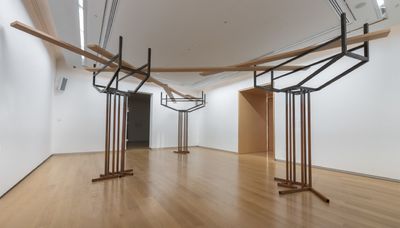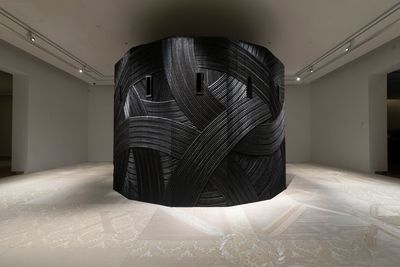
27 Sep Ana Iti Wins New Zealand’s $50,000 Walters Prize
Source Credit: Content and images from Ocula Magazine. Read the original article - https://ocula.com/magazine/art-news/ana-iti-wins-new-zealands-50000-walters-prize/
Iti was nominated for Aotearoa’s most prestigious contemporary art award alongside Juliet Carpenter, Owen Connors, and Brett Graham.

Ana Iti. Photo: Sophie Davis.
Ana Iti was named the winner of the 11th Walters Prize at a celebration held at Auckland Art Gallery Toi o Tāmaki tonight.
Iti’s winning work, A resilient heart like the mānawa (2024), is a steel and wood installation inspired by Rāwene wharf, which was built on the Hokianga harbour in 1881. The lower portion of the steel is rusted, as if it were immersed in water, and the sounds of sloshing waves and thumping machinery—the soundtrack of a busy harbour—accompany the sculptural elements. The work’s title references native mangroves, suggesting the strength of Māori in the face of colonisation.
Iti was selected by the prize’s international judge, Professor Bonaventure Soh Bejeng Ndikung, the director and chief curator of Haus der Kulturen der Welt (HKW) in Berlin.
Ana Iti, A resilient heart like the mānawa (2024). Exhibition view: Auckland Art Gallery Toi o Tāmaki, 2024. Courtesy the artist and Auckland Art Gallery Toi o Tāmaki.
He said he chose Iti’s work ‘because of the radicality of its manifestation. Stripped to the bare minimum, the work shares something in common with great poetry: the ability of accessing multiple universes through the availability of a few words.’
‘The concreteness of metals of the de-concretised wharf infrastructure that stand majestically in the gallery express the weight of histories of industry, of extractivism, of capitalism, of the colonial enterprise and of connections in Rāwene that was transformed into a timber town with a mill and shipyards in the early 1800s,’ he added. ‘While in a very delicate balancing act, the kauri timber floats almost unhinged over the heads of the visitors.’
Professor Ndikung said despite their different ages, disciplines, and sociocultural affiliations, all four nominees excelled similarly ‘in the depth and breadth of their arts’.
Brett Graham, Ka Wheeke (2024). Exhibition view: Auckland Art Gallery Toi o Tāmaki, 2024. Courtesy the artist and Auckland Art Gallery Toi o Tāmaki.
Works by all four nominees are showing in the Walters Prize exhibition (6 July–20 October 2024).
Brett Graham‘s Ka Wheeke (2024) is a huge wood carving in the shape of a 19th-century naval gun turret. Specifically, it refers to the Pioneer, New Zealand’s first purpose-built war vessel, which was commissioned in 1863 and used on the Waikato River against the Māori king. The work’s title references a quote from the second Māori king, Tāwhiao, who said, ‘the victory is yours today; tomorrow will be your day of reckoning’. Beneath the carving is a surrender-white damask and velvet floor.
Juliet Carpenter, EGOLANE (2022–24). Exhibition view: Auckland Art Gallery Toi o Tāmaki. Courtesy the artist and Auckland Art Gallery Toi o Tāmaki.
Juliet Carpenter presented a reimagination of her 2022 film installation EGOLANE, for which she was nominated. The work is a 16 minute video projected onto the windscreen of an old Mitsubishi Legnum ST. It’s best experienced sitting inside the car, where a synthy soundtrack plays through the car’s speakers. The video follows a woman travelling in a driverless car, who narrates her emotional and existential condition—’my end was doomed to be on the road, girl boss, warrior’—in the lead up to a fatal crash, and beyond.
Owen Connors presented narrative altarpiece paintings in his installation Land of doubts & shadows (2024), which reinterprets lost mystic and Queer symbology. The egg tempera on birch paintings are displayed on custom steel frames with scagliola (fabricated stones) by Katherine Rutecki. Banal boyhood scenes—studying knots, rowing a boat, making shadow animals—are juxtaposed with shocking violence, including a disembowelled sheep, a dead man’s leg, and a rock raised overhead, as if its wielder is about to brain a victim.
Owen Connors, Land of doubts & shadows (2024) (detail). Exhibition view: Auckland Art Gallery Toi o Tāmaki, 2024. Courtesy the artist and Robert Heald Gallery.
Named after artist Gordon Walters (1919–1995), the The Walters Prize was established in 2002. Previous winners include Maataho Collective and Maureen Lander (2021), Ruth Buchanan (2018), and Shannon Te Ao (2016).The prize is now awarded every three years, alongside the Aotearoa Triennial exhibition, which launched this year to spotlight emerging New Zealand artists. —[O]
Source Credit: Content and images from Ocula Magazine. Read the original article - https://ocula.com/magazine/art-news/ana-iti-wins-new-zealands-50000-walters-prize/





